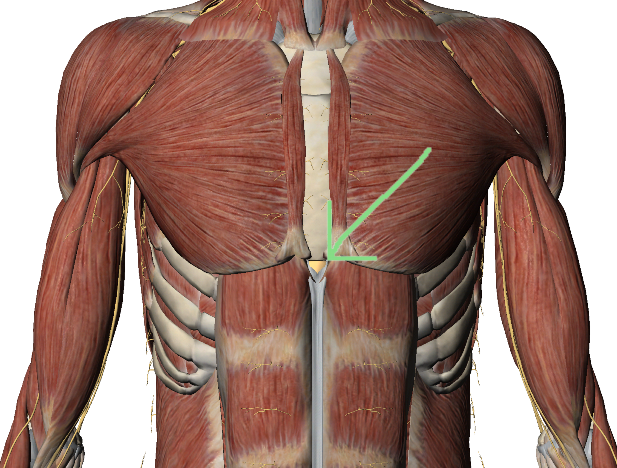Before we go in the detail of sternum lump pain treatment, it will be good to have a look at the anatomy of Xiphoid. The small Xiphoid extends from the place where the lowest ribs are attached to the breastbone or sternum. It looks like a small hole. It also has a sharp tip resembling that of a sword. The part of the sternum located just above the Xiphoid Process is known as the manubrium. The Xiphisternal joint is the immobile point between the two sternum portions.
It is like cartilaginous extension and can be seen as well as felt in infants. At this stage, the Xiphoid Process is just like a lump that is located below the sternal notch. With the passage of time, it becomes harder and gets fused to the sternum as the individual grows up. The cartilage becomes hard and bony anytime between the age of 15 and 29 years. This pattern of becoming hard with age is quite common in human body. Many other human bones such as the growth plates of the limb bones are also initially cartilages that are later replaced by bones.
It serves like an attachment for many important muscles like the abdominal diaphragm, which is a sheet-like muscle necessary for breathing. The rectus abdominus and the transversus thoracis muscles are also attached to the Xiphoid. Since it is an unsupported structure and can break off under pressure, so extra care should be taken while treating it. A broken Xiphoid can damage various internal organs and cause serious pain and inflammation in the chest. There are many CPR hand positions that are unsafe for women especially as the hand extends past the sternum base in these positions. These hand positions increase the risk of breaking the Xiphoid Process.

Xiphoid Process: Sternum Lump Pain Treatment
Now after having a little idea, what actually Xiphoid Process is, below you can find the information about its pain and treatment.
Xiphoid Process Pain
Pain starts when this structure bends to form a lump that sticks out from an area around the chest. Generally this lump itself does not cause any problem for the individual in the initial stage. However, it can be very uncomfortable when the individual tries to lift weight or eats a heavy meal.
This is how this condition behave in its initial stage otherwise it can cause serious problems. Severe pain and inflammation in the swollen Xiphoid Process are common symptoms of it.If this extension breaks off completely due to some accident or trauma, it can lead various health problems such as chest pain, breathing difficulties and nausea.
Causes of Lump in Xiphoid Process
There may be several reasons because of them human body can develop lump in Xiphoid Process including:
- after extreme weight loss, one can feel the extension sticking outwards
- the excess weight might put enough pressure on the Xiphoid Process to bend it.
- A serious chest trauma or an accident can also damage this small bone.
- Activities like bending, lifting heavy objects and eating heavy meals can trigger acute pain in the structure.
- An extended Xiphoid Process is often confused with a tumor, hernia or even cancer. However, the lump near the end of the sternum is generally harmless although care should be taken to avoid its complete break off.
Xiphoid Process Pain Treatment
If you are experiencing pain in the lower parts of the sternum, it is highly recommended to consult your doctor immediately. Usually, various tests and examinations like the x ray are done on the patient to understand the situation properly. On the bases of the x ray report, method of treatment is determined. Some available treatments are given below:
- Hot or cold treatment is the most commonly used treatment for this condition.
- In addition to this, there are also various medicines that help to lessen the pain.
- Patients are also advised to use elastic rib belts to avoid further dislocation of the Process.
- It is also treated by using anesthetics and steroid injections.
- It is possible to remove the Xiphoid Process by surgery. The removal process is known as Xiphoidectomy and is very complex.
- The Xiphoid Process itself, does not have any serious functions. However, it works as an anchor for several important muscles. It can cause serious pain and health problems in case it breaks off the sternum.
 Health & Care Information
Health & Care Information 

